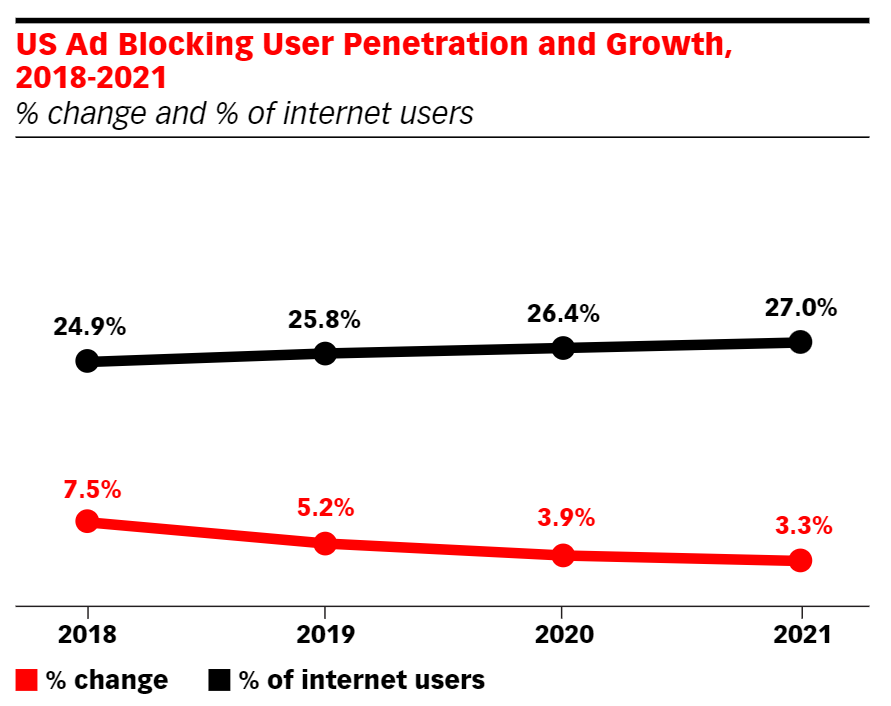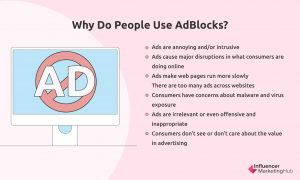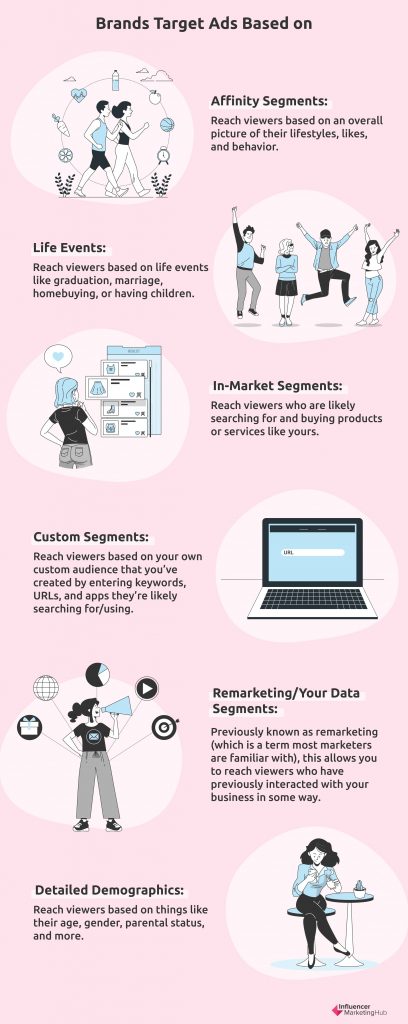YouTube ads have the potential to reach 2.56 billion users. However, with the use of browser extensions and apps that block ads, this reach obviously starts to dwindle.
With so many ad blockers available, do brands need to be concerned that their target audience will be able to avoid the ads they’ve put so much time and ad budget behind?
In this article, we’re going to discuss what YouTube AdBlock is, investigate how many people are actually using some kind of tool to block their YouTube ads, and cover why you don’t need to worry about ad blockers.
Should You Be Concerned About YouTube AdBlockers?
What are YouTube AdBlockers?
YouTube AdBlockers are browser extensions that keeps ads from popping up and interrupting videos as users browse YouTube. In fact, there are a number of them available on Google Chrome’s extension marketplace now.
Anyone who has an ad blocker installed won’t see any advertisements while they watch YouTube videos, allowing them to have an uninterrupted video streaming experience.
While I’m sure we can all agree that ads can be annoying, ad blockers impact the revenue of both YouTube and its creators. This is why many businesses and YouTubers alike are concerned that ad blockers could potentially hinder their income.
However, even though ad blockers exist and people will likely continue to use them, we’re going to walk you through why you don’t need to worry about them.
How Many People Use Ad Blockers?
According to eMarketer research, an estimated 27% of US internet users were using ad blockers in 2021. And we can also see that the growth rate of ad blockers in use has also slowed, dropping from 7.5% from 2017 to 2018 to 3.3% from 2020 to 2021.

Source: emarketer.com
This shows us that while ad blockers are still in use, and more people are using them each year, it’s far from the majority and the growth is stalling.
However, the above figures are talking about all ad blockers. We’re more concerned with YouTube ad blockers, and HubSpot did their own survey to find out more in that regard.
Their data showed that 63% of respondents don’t use any type of ad blocker while only 11% said yes, they do use an ad blocker to keep YouTube ads from appearing.
If just around 9 out of 10 YouTube users are blocking ads, that still leaves around 2.3 billion users who could still potentially see your video ads.
Why Do People Use AdBlock?
Now that we know just how many people are using ad blockers, let’s talk about the why. What are their motivations for removing ads from their day-to-day web surfing?
Based on surveys run by MarketingSherpa, HubSpot, and PageFair, some of the most common reasons include:
The most common theme is simply that ads are annoying, disruptive, and invasive. This could mean that internet users or YouTube viewers would be frustrated if they did see your ad pop up, putting a bad taste in their mouth about your company.
Personally, we welcome the use of AdBlock if it can keep something like that from happening. Those consumers wouldn’t purchase from your business anyway, so there’s no need to be worried about missing out on those views.
Why You Don’t Need to Be Concerned About YouTube AdBlockers
Based on the data showing the number of consumers actually using ad blockers and Google’s assumed stance on ad blockers, we don’t think YouTube AdBlock is something to be concerned about at this point.
Not convinced? We’ve got three reasons why below.
1. AdBlock users likely aren’t going to click on your ads anyway.
If someone is so concerned about avoiding ads that they’re going to use an ad blocker, they’re likely not going to click on your ad to head over to your landing page. This means you’d be paying for them to watch your ad when they have absolutely no intention of converting.
In the end, that means these users are saving you money. You don’t need to be concerned about losing out on viewers that simply won’t convert.
2. There are fewer people using ad blockers than not.
We’ve seen the numbers. The vast majority of people are not using any type of ad blocker. And when we look specifically at YouTube, only 11% of survey respondents admitted to using an ad blocker.
More than that, the growth of AdBlock usage is slowing. So even though more people are using ad blockers each year, it’s not at an alarming growth rate.
Because you still have access to so many other YouTube viewers, ad blockers really don’t need to play much of a factor into your video marketing. Which brings us to our last point.
3. You can navigate your video marketing strategy around ad blockers.
If you’re still keeping YouTube AdBlock in the back of your mind, that’s fine. You can still navigate your video marketing strategy around them.
Let’s talk about how.
Don’t rely exclusively on YouTube.
YouTube is not the only outlet you can place your video ads. There are a number of different social media platforms you can utilize to cross-promote your video content and make sure your ads are seen by a large enough audience.
A few to consider are:
- Snapchat
Each of these platforms gives you the ability to share the video ads you’ve worked so hard on and want to put in front of the right audience.
And for B2B companies, LinkedIn is yet another platform to consider.
This isn’t to say you should use these instead of YouTube. They’re padding in your video advertising strategy to ensure you’re reaching as many people as possible.
Create valuable, native video ads.
The first thing every brand should do is revisit the ads they’ve already created. Are these actually adding value to YouTube watchers? Is your target audience going to be interested? And most importantly—are your ads disruptive?
Making sure you’re only placing valuable ads that don’t create obnoxious disruptions (read: loud noises or salesy voiceover that can put off viewers) will be key to a successful video ad strategy.
If you can create valuable, native YouTube ads that feel like a part of the overall YouTube experience, your ads won’t frustrate viewers and drive more users to turn on AdBlock. Instead, they’ll start to welcome ads—especially those that are helpful to them.
Focus on proper ad targeting.
The best way to ensure success with your YouTube advertising strategy is to make sure you’re targeting the right audience. Regardless of ad blockers, focusing on proper targeting is how you make sure your ads are reaching the right people.
It’s a good idea to create multiple target audiences that you can reuse each time you run a new video ad. You can have a separate audience for each of your customer personas as well as an audience based on different products, services, or features your business offers.
YouTube’s advertising platforms allow brands to target ads based on:
- Affinity Segments: Reach viewers based on an overall picture of their lifestyles, likes, and behavior.
- Life Events: Reach viewers based on life events like graduation, marriage, homebuying, or having children.
- In-Market Segments: Reach viewers who are likely searching for and buying products or services like yours.
- Custom Segments: Reach viewers based on your own custom audience that you’ve created by entering keywords, URLs, and apps they’re likely searching for/using.
- Remarketing/Your Data Segments: Previously known as remarketing (which is a term most marketers are familiar with), this allows you to reach viewers who have previously interacted with your business in some way.
- Detailed Demographics: Reach viewers based on things like their age, gender, parental status, and more.
Make sure you’re taking advantage of YouTube’s targeting so that you’re still reaching a large audience—regardless of YouTube AdBlock.
Fearlessly Add YouTube to Your Marketing Strategy
Just because people have the ability to block YouTube ads doesn’t mean you need to keep your ad budget off the platform. The majority of YouTube’s 2.56 billion users don’t have an ad blocker installed, meaning you’re still likely to reach your target audience.
So we say feel free to fearlessly add YouTube to your digital marketing strategy, creating and promoting incredible video ads that generate buzz around your brand.
Frequently Asked Questions
Is AdBlock blocked by YouTube?
YouTube (and Google as a whole) has not blocked AdBlock, and in fact, there are a number of ad blockers available in the Chrome extension store. This is because Google still wants people to use its products, even if they’re blocking the ads. And as we mentioned, people who want to block ads likely wouldn’t click on them anyway, so Google knows it’s not missing much from these users.
How do you block ads on YouTube?
There are a number of ad-blocking tools available for Google and YouTube that keep ads from showing while they use these platforms.
Does AdBlock hurt YouTubers?
If a consumer is using an ad blocker, they’re not being shown ads, therefore the creators of the videos they watch aren’t able to receive revenue from those viewers. While this can impact their income, we’ve discovered that the majority of YouTube users aren’t using these tools.
Are ad blockers illegal?
No, using an ad blocker is not illegal. Users with apps or extensions like this added to their devices do not need to worry about getting into legal trouble or being blocked by YouTube or Google.
Does an ad blocker cause YouTube to lose money?
In short, yes. If the ads aren’t being shown, there’s no ad cost for YouTube to gain. However, they tend to accept this loss because their main goal is to have as many people using their platform as possible—even if they’re using an ad blocker.




